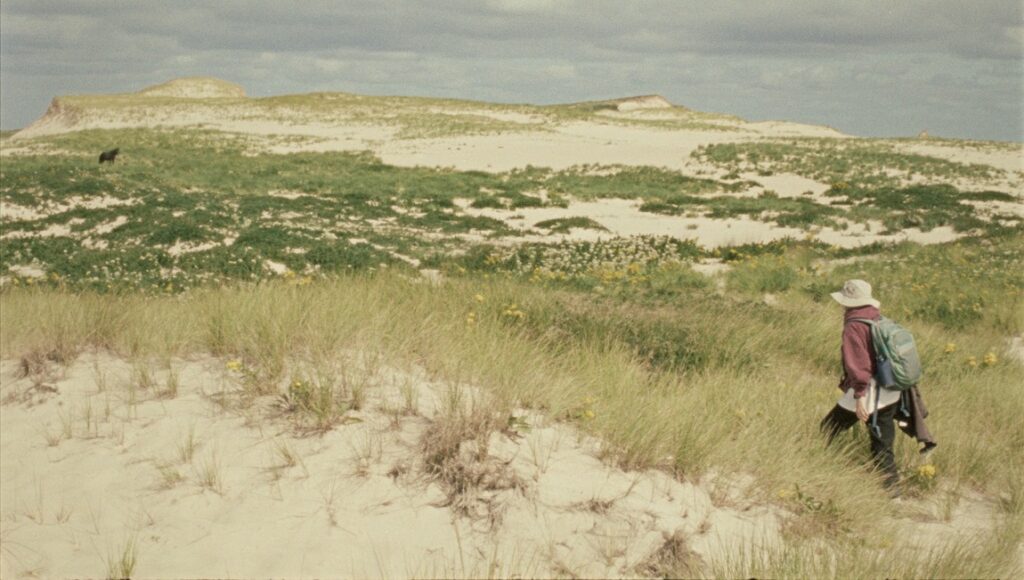Sable Island, the crescent-shaped sandbar located in the North Atlantic Ocean, is the site of Jacquelyn Mills’ debut feature film Geographies of Solitude. It’s an isolated area, nearly 200 miles southeast of Nova Scotia, and the film’s title hints at the quietude that defines its 12 square miles of land. Such stillness is a result of the small human population: Except for those in archival footage, the only people we see are Mills and Zoe Lucas, a naturalist who has conducted research on the island for more than four decades. She’s a genial, dedicated person, the kind that researchers need to be to live such purposeful lives. While watching Geographies of Solitude, one remembers the truth underlining all great people in science: In their unceasing and underappreciated work, they will never be celebrities. Geographies of Solitude is lovely because it doesn’t try to elevate Lucas to such superstar status; instead, we witness her simply going about day-to-day operations, showcasing the joy therein.
Initially, Lucas came to Sable Island because of its famed horses, but she felt an extreme desire to come back. She found a path to do this through volunteering as a cook, which led her to working alongside researchers. “It’s so compelling to be in a place where you’re learning things directly rather than reading about it in a book,” she says. It’s this enthusiasm for hands-on discovery that is crucial to Geographies of Solitude’s ethos. In periodic flashes of avant-garde filmmaking, Mills uses materials from the island itself to present dazzling lights and colors. She incorporates horsehair and sand, develops film in yarrow and seaweed, and uses contact microphones to capture the sound of specific organisms. These moments are less evocative for the images and audio themselves than what they telegraph: Mills is marrying her passion with Lucas’s, engaging in her own analogous research, but also deepening their relationship in the process. For a film that is subtly underlined by the innate loneliness of Lucas’ life, the act proves notably heartwarming.
For the most part, though, Geographies of Solitude is a straight-ahead documentary. Mills presents striking images of both landscapes and animals, with the graceful swaying of marram grass cutting to the resplendence of horses’ manes. Alongside such lovely wide shots are those in close-up: Lucas writing her findings in a notebook, the endless scrolling of data-filled spreadsheets, the careful handling of dead animal bodies. This juxtaposition of intimate research with grandiose spectacle highlights the feedback loop that is Lucas’s life: The obvious allure of this place led to this commitment to research, and it’s only in doing such work that more beauty is revealed. One testament to her neverending discoveries is how, after deciding to keep track of the island’s invertebrates, Lucas herself identified more than 70 new species.
Much of Geographies of Solitude’ second half, however, points to less enthralling encounters: Specifically, the huge amount of pollution that arrives on the island. At one point, Lucas reveals that 72 percent of the 300 bird corpses she’s found had stomachs filled with plastic. There’s also an incredibly large number of balloons that land on Sable, including one that came all the way from Indiana. Mills is smart to not just make this a clobbering of didactic moralizing though, as this problem is always coupled with Lucas’ solitary life; it’s only here, away from the rest of the world and in the distinct absence of other people, that one can really understand the grand ramifications of littering. There’s a hopelessness to it all, and as the film winds down, Geographies of Solitude moves into necessarily personal territories. “I lost track of everything else,” she confesses. “It appears that my life is Sable Island. That’s all I have, that’s all I do.” There’s a tinge of sadness and regret, but as the film concludes with her talking about the circle of life, there’s contentment in knowing she’s merely part of a greater ecosystem. She’s lived a full life and has done her part, certainly more than most, and she understands that one’s life can only ever be just that.
Published as part of Berlin Film Festival 2022 — Dispatch 1.


Comments are closed.